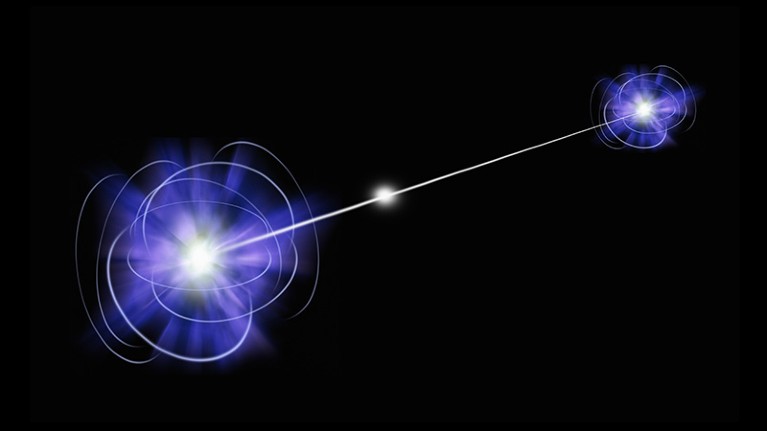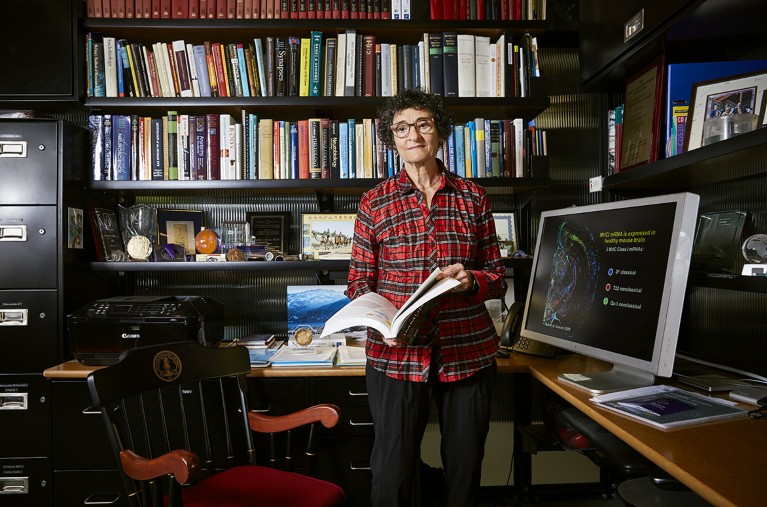Hello Nature readers, would you like to get this Briefing in your inbox free every day? Sign up here

Quantum entanglement is at the centre of a mathematical proof.Credit: Victor De Schwanberg/Science Photo Library
Extent of quantum spookiness is unknowable
Quantum entanglement allows two objects to affect each other’s behaviour instantly across vast distances — what Albert Einstein called “spooky action at a distance”. But by how much? The answer could be incalculable, says a team of 5 researchers in a 165-page preprint. In one fell swoop, their proof solves a number of related problems in pure mathematics, quantum mechanics and a branch of computer science known as complexity theory. If it holds up, “it’s a super-beautiful result” says theoretical quantum physicist Stephanie Wehner.
Reference: arXiv preprint
Supercomputer uncovers hidden extinctions
Palaeontologists have used the world’s fourth most powerful supercomputer, Tianhe II, to mine a database of more than 11,000 fossil species that lived from around 540 million to 250 million years ago. The effort will help scientists to identify the causes of mass extinctions — such as the event at the end of the Permian period, some 252 million years ago, that wiped out more than 95% of marine species. It will also aid understanding of less-dramatic species die-offs and rebounds that have been hard to uncover because of gaps in the fossil record.
Australian bush fires derail research
On top of the heartbreaking loss of lives and livelihoods, the Australian bush fires have interrupted research, destroyed equipment and hit vulnerable plant and animal populations to which researchers have dedicated their careers. At the same time, ecologists are preparing to make the most of the situation — by taking the opportunity to further suppress the populations of invasive species, for example.
Features & opinion
‘I preach work-life balance, but I don’t have it.’
Actinide chemist Polly Arnold, director of the chemical sciences division at the storied Lawrence Berkeley National Laboratory, talks about teaching her students to embrace failure, loving being an introvert and why chemists are the meanest scientists. She compares her thinking process to shaking a bag of paperclips: “As long as you’ve accumulated enough information, after a while the bag has been sufficiently shaken up and you can pull out that long string of paperclips all perfectly chained together and you can see the answer you are looking for, or the question you need to ask,” says Arnold. “I just wish I’d known at the start of my career that my ideas were good!”
Where all the crisp flavours come from
The gas chromatograph can take the credit (and the blame) for the explosion of potato-crisp flavours, argues food historian Nadia Berenstein. The device offered food scientists a powerful tool for identifying the volatile compounds that define our favourite tastes. Take a journey from the first flavoured mass-produced crisps, on which you sprinkled your own tiny sachet of salt, to a future in which our insect-protein meals are enhanced with the tastes of a bygone age.
Strange objects at the centre of the Galaxy
In this week’s Nature Podcast, we hear that researchers have uncovered a population of dust-enshrouded objects orbiting the supermassive black hole at the centre of the Galaxy. Plus, a London landmark’s height lends itself to a physics experiment, and generous behaviour in parrots.
Nature Podcast | 26 min listen
Subscribe to the Nature Podcast on iTunes, Google Podcasts or Spotify.
Books & culture

US president Ronald Reagan based his tax cuts of the 1980s on questionable ideas.Credit: Bettmann
The dangers of fringe economics
Three books warn of the perils of basing policy on untested ideas. Economists Simon Bowmaker and Paul Krugman separately explore how ideas untethered by evidence managed to influence US policy — and just keep coming back. And last year’s economics Nobel prizewinners, Abhijit Banerjee and Esther Duflo, together probe hot topics such as climate change, immigration and the viability of continued growth.
Five best science books this week
Barbara Kiser’s pick of the top five science books to read this week includes data judo, the interconnected self and the dystopia in Silicon Valley.
Where I work

Carla Shatz is a biologist and neurobiologist and director of the Stanford Bio-X interdisciplinary centre at Stanford University in California.Credit: Gabriela Hasbun for Nature
“The order of my desk symbolizes an orderly mind,” says neurobiologist Carla Shatz. “Because of that, my mind has room to notice things that don’t fit the pattern. This is partly why my lab has been able to think outside the box and has worked on themes that don’t fit the expected.”
